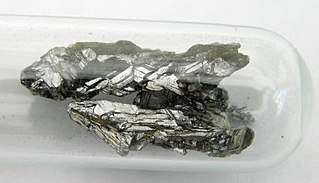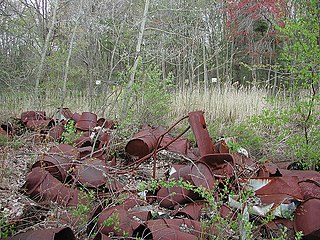| Michigan Disposal (Cork Street Landfill) | |
|---|---|
| Superfund site | |
| Geography | |
| City | Kalamazoo, Michigan |
| County | Kalamazoo |
| State | Michigan |
| Coordinates | 42°15′31″N85°32′34″W / 42.258695°N 85.542874°W |
| Information | |
| CERCLIS ID | MID000775957 |
| Contaminants | antimony, aroclor 1254, arsenic, barium, chromium, manganese, arsenic, Polycyclic aromatic hydrocarbons, cadmium, chrysene |
| List of Superfund sites | |
Michigan Disposal Service, also known as Kalamazoo City Dump, Kalamazoo City Landfill, Dispose-O-Waste and the Cork Street Landfill, is a 68-acre (27.5 hectare) Superfund site in Kalamazoo, Michigan. [1] Davis Creek is adjacent to the site. It is one of six Superfund sites in the Kalamazoo River watershed. [2]

Superfund is a United States federal government program designed to fund the cleanup of sites contaminated with hazardous substances and pollutants. Sites managed under this program are referred to as "Superfund" sites. It was established as the Comprehensive Environmental Response, Compensation, and Liability Act of 1980 (CERCLA). It authorizes federal natural resource agencies, primarily the Environmental Protection Agency (EPA), states and Native American tribes to recover natural resource damages caused by hazardous substances, though most states have and most often use their own versions of CERCLA. CERCLA created the Agency for Toxic Substances and Disease Registry (ATSDR). The EPA may identify parties responsible for hazardous substances releases to the environment (polluters) and either compel them to clean up the sites, or it may undertake the cleanup on its own using the Superfund and costs recovered from polluters by referring to the U.S. Department of Justice.

The Kalamazoo River is a river in the U.S. state of Michigan. The river is 130 miles (210 km) long from the junction of its North and South branches to its mouth at Lake Michigan, with a total length extending to 178 miles (286 km) when one includes the South Branch. The river's watershed drains an area of approximately 2,020 square miles (5,200 km2) and drains portions of eight counties in southwest Michigan: Allegan, Barry, Eaton, Van Buren, Kalamazoo, Calhoun, Jackson, Hillsdale, Kent and Ottawa. The river has a median flow of 1,863 cubic feet per second (52.8 m3/s) at New Richmond, upstream from its mouth at Saugatuck.

A drainage basin is any area of land where precipitation collects and drains off into a common outlet, such as into a river, bay, or other body of water. The drainage basin includes all the surface water from rain runoff, snowmelt, and nearby streams that run downslope towards the shared outlet, as well as the groundwater underneath the earth's surface. Drainage basins connect into other drainage basins at lower elevations in a hierarchical pattern, with smaller sub-drainage basins, which in turn drain into another common outlet.
The site opened in 1925 as a privately run facility and operated as a dump and incinerator until 1961 when it was purchased by the City of Kalamazoo. In 1981 it was purchased by Dispose-O-Waste, now known as Michigan Disposal Service.
A 1967 Solid Waste plan commissioned by the Kalamazoo County Road Commission, stated that the incinerator had no controls and produces an air pollution problem. [3] Further, the authors state that the County's method for waste disposal creates water pollution and is detrimental to public health and is not in compliance with Michigan Act 87 of 1965.
The EPA Superfund Record of Decision is dated September 30, 1991. [4]
Upon EPA review, the site was found to be leaching antimony, aroclor 1254, arsenic, barium, chromium, and manganese. The sediment was found to contain arsenic, a number of Polycyclic aromatic hydrocarbons, cadmium, and chrysene. [5]

Antimony is a chemical element with symbol Sb (from Latin: stibium) and atomic number 51. A lustrous gray metalloid, it is found in nature mainly as the sulfide mineral stibnite (Sb2S3). Antimony compounds have been known since ancient times and were powdered for use as medicine and cosmetics, often known by the Arabic name, kohl. Metallic antimony was also known, but it was erroneously identified as lead upon its discovery. The earliest known description of the metal in the West was written in 1540 by Vannoccio Biringuccio.

A polychlorinated biphenyl (PCB) is an organic chlorine compound with the formula C12H10−xClx. Polychlorinated biphenyls were once widely deployed as dielectric and coolant fluids in electrical apparatus, carbonless copy paper and in heat transfer fluids.

Arsenic is a chemical element with symbol As and atomic number 33. Arsenic occurs in many minerals, usually in combination with sulfur and metals, but also as a pure elemental crystal. Arsenic is a metalloid. It has various allotropes, but only the gray form, which has a metallic appearance, is important to industry.










